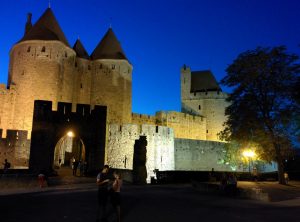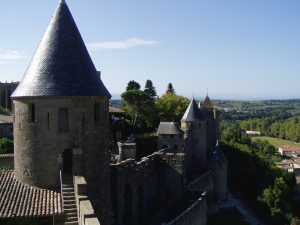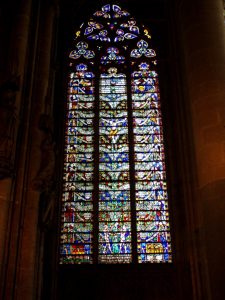Sat: We managed to “escape” from Saintes Maries: it was quite a wrench knowing we’d be heading North and into cooler climes.
That said, after rounding Montpellier and Beziers, I noticed a temperature display showing 31°C, so maybe not so cool after all? In fact, we’ve not headed N at all: we’ve actually managed to go slightly further South, and a lot further West, to Carcassonne.
Carcassonne hadn’t really been on my radar, but Joy wanted to visit the mediaeval old town (la Cité), dating back to early Roman times. We arrived there about 5pm and were immediately mystified by the charging arrangements for the aire. No matter, we can deal with it tomorrow.
We took a quick stroll into la Cité in the evening: it was all lit up (the days are getting shorter now, and it’s dark by 8:30pm), and made plans for a proper revisit in the morning.

Sun:
If you’re ever in the South West of France, make sure you pay a visit to Carcassonne; it really is well worth it. It’s free to enter the old town itself, though you have to pay to get into the inner castle. At €8.50 a head, it seemed a bit steep, but the informative and well thought-out route round the castle and the ramparts was value for money. The city is perched high up on a promontory above the plains, giving excellent views to the Black Mountains in the North, and the Pyrenees to the South West.
Although some earlier Roman mosaics have been discovered, and there were certain to have been earlier settlements here, very little remains from those periods. The major part of the town is 13th century, with most of the early building work being from around 1220.

The city itself was one of the Cathar settlements – the order of semi-Christianity that wanted nothing to do with a pope in Rome. Consequently, they were the subject of a 13th century crusade and the Inquisition. The city – despite it many levels of defence – eventually fell to Simon de Montfort, wherupon the “heretics” were disposed of and the catholicism was re-established.
Eventually, the city lost its strategic military importance and fell into disuse as the “new town” on the plains below and across the river flourished as a commercial centre. In 1822, an eminent architect was appointed to restore parts of the city to prevent further dereliction. Over the next 50 years, work was done to restore the city to the architect’s vision of how it might have been in the 13th century. This is pretty much how the city appears today.

We also took a look inside the Saint Nazaire church within the city walls: It was a cathedral until 1803, and houses what are reputed to be the best stained glass windows in the South of France. It also has one of the oldest organs in existence; traceable back to 1522.

We’d found out some time ago that Tourist Information offices in France all seem to offer free WiFi. Whilst in Saintes Maries, it was the only way to connect without spending a fortune with T-Mobile. Unfortunately, it was also a 3km bike ride each way and the connection there was sporadic at best. In Carcassonne, there is a TI office just inside the city walls – only about 10 mins walk from where we’re parked. But it’s also the first one we’ve come across that doesn’t have WiFi. So not sure when I’m going to be able to post this!
By 3pm, we were done and back in the van. Figuring out the payment machine took a little while, and we finally started the long journey North.
I’d picked out an aire in a remote town off the beaten highway – Cordes sur Ciel – as our stopover for the night. We rolled-up here about 6pm. Guess what? It has its own medieval Cité that we’ll have to visit in the morning. And it seems to be firmly on the tourist/history/culture trails judging by the number of camper vans in the aire!